The South Asian Eatwell Guide
Guest author: Registered Dietitian Fareeha Jay
Fareeha is a UK Registered Dietitian who is extremely passionate about providing the best available nutrition advice to the people with Southern Asian background. She believes that they are very receptive and eager to learn but don’t have access to advice that is easy to understand and digest. We invited Fareeha to tell us all about the popular and much-needed new resource she has developed – ‘The South Asian Eatwell Guide’. She also shares a recipe for masala oats.
South Asians are at a higher risk of developing heart disease and type 2 diabetes compared to other ethnic groups. These risks can be prevented by adopting a healthy lifestyle; achieved with the provision of healthy eating education for the communities. The Eatwell Guide is a fabulous tool that helps people eat a healthy and well-balanced diet. However, is it ethnically diverse enough? Is it an actual representation of the South Asian diet?
The Need for a South Asian Eatwell Guide
Prevalence of diabetes is high among South Asian communities in UK, with an increased risk of complications such as coronary heart disease and end-stage renal disease. It is estimated that there are nearly 400,000 people with diabetes from South Asian background living in the UK. This makes them one-fifth of the total UK diabetes population [1]. In addition, current data suggests that the BAME communities in UK are at higher risk of severe COVID-19 complications and deaths [2].
The high prevalence of these health conditions among South Asian communities is because of genetic predisposition to adiposity and insulin resistance. This begins during foetal development, though this alone is not the cause – lifestyle factors also play an important role [3]. Whilst the former cannot be modified, certainly something can be done to modify lifestyle factors. To encourage these changes, there is a need to educate people on diet, physical activity and investing in health education and food policies [4].
One fabulous policy tool is the Eatwell Guide, which defines government recommendations and helps people have a balanced diet [5]. It makes healthy eating easier to understand by giving a visual representation of food and drinks. However, each food group is visually represented by foods consumed primarily by the White British ethnic group.
There are barriers for the South Asian population of UK to adopt a healthy eating lifestyle because of different cultural and social aspects. If health messages are conveyed in a culturally appropriate way, it will lead to acceptability and adherence [6]. Culturally intelligent guidance is needed [7] to get the message across on how to have a healthy well-balanced diet. Hence there is need for developing a South Asian Eatwell Guide.
Developing The South Asian Eatwell Guide
Most of my work as a dietitian is with South Asian communities, doing either one-to-ones or group presentations. Previously, I would go through the Eatwell Guide, using props and pictures of South Asian foods and how they fit in to each food group. This was time consuming and confusing. This led me to develop a South Asian Eatwell guide, which was further improved by carrying an online survey on The South Asian Eatwell Guide. 132 South Asian participants from all over the UK were part of the survey.
Table 1: Percentage of participation in different cities of UK
| Cities | Percentage |
| London | 46% |
| Manchester | 31.6% |
| Birmingham | 30.3% |
| Leicester | 21.1% |
| Bristol | 19.8% |
| Glasgow | 9.2% |
| Oxford | 6.6% |
| Harlow | 2.6% |
| Wolverhampton | 1.3% |
| Stafford | 1.3% |
| Brentwood | 1.3% |
| Chelmsford | 1.3% |
| Buckinghamshire | 1.3% |
93.9% of the participants wanted a South Asian version of the Eatwell Guide, whilst 95.4 % believed that having a South Asian Eatwell Guide would help them make better food choices. Once I developed the South Asian Eatwell Guide, the response was phenomenal. All my patients were more receptive and engaged. Many reported that for the first time in life they understood what healthy eating was. It was a mutual belief that eating healthy meant they had to swap traditional meals with a Caucasian diet.
Modification of The Eatwell Guide
Findings show that South Asian communities exhibit attributes from both their ancestral as well as host cultures [8]. Therefore, none of the foods from the Eatwell Guide were removed and further South Asian food additions were made.
Carbohydrates
Taro root: Eaten as a main meal among South Asians
Sweet potato: A very popular snack topped with spices
Thepla: A flatbread made from wheat or millet flour and spices
Chapatti: Made from flour. Almost all meals comprise of chapatti
Idli and dosa: Made from rice and lentil batter. Mostly eaten at breakfast
Whole grain flours: Different types of chapattis/rotis are made from different types of flours
Poha: Flattened rice, in many households eaten more than rice. A very popular breakfast
Tapioca and semolina: Used in desserts or added in different recipes
Fruit and Vegetables
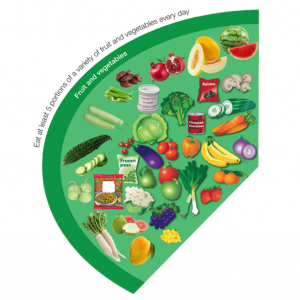
Watermelon and yellow melon: Popular fruit specifically eaten in the evenings
Pomegranate/guava/mangos: Different varieties found in South Asian supermarkets and extremely popular among the South Asian communities
Dates: Most of South Asians have dates at home all year round
Indian squash, bitter gourd, okra, bottle gourd: Cooked as curries
Mooli: Commonly eaten as part of salads
Protein
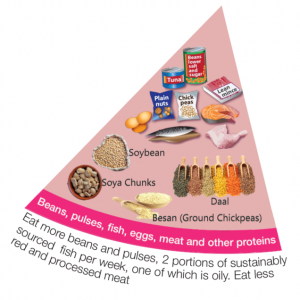
Soybeans, soya chunks, ground chickpeas: Many South Asians are vegetarians and make different recipes from these foods
Daal: The term ‘daal’ is used instead of lentils just to make it more relatable
Dairy and Alternatives
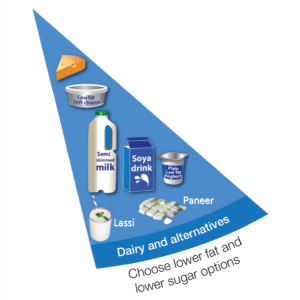
Paneer: A type of cheese. Main meals comprise of paneer
Lassi: Drink made from yoghurt and consumed with meals in summer
Foods High in Fat, Salt & Sugars
Mithai: South Asian sweets
Samosa: A popular snack
Halwa: Dessert made regularly in South Asian households. There are lots of versions of it though the most popular ones are made from semolina and carrots.
Portion Guides/Charts
Summary
The South Asian Eatwell Guide will be extremely useful for all health professionals working with South Asian communities. When patients feel that their care providers do not understand their beliefs and culture, many times it delays and prevents them from seeking care. Many might even find it intimidating to consult health care professionals. Provision of culturally-competent recommendations will encourage patients to be more receptive and it will improve the process of providing care [9].
People from the Asian ethnic group make up the second largest percentage of the UK total population [10]. To support diversity and inclusion, Public Health England (PHE) should consider publishing The South Asian Eatwell guide on all official platforms and websites.
Recipe: Masala Oats
I am going to share a recipe which is a best example of South Asian acculturation. Oats are not eaten traditionally but have been adapted by the South Asian cuisine according to own flavours and palate.
Ingredients
4 teaspoons of oil
½ teaspoon mustard seeds
½ teaspoon cumin seeds
½ teaspoon ginger paste
½ teaspoon garlic paste
1small onion
2-3 green chillies
1 tomato
1/3 teaspoon turmeric
Salt to taste
4 tablespoon oats
Water ½ cup
Coriander
Method
- Heat oil in a pan, add mustard seeds and cumin and let it sizzle.
- Add ginger and garlic paste.
- Cook few minutes and then add onions. Sauté for a minute.
- Add tomatoes and greens chillies followed by turmeric powder and salt.
- Put oats in the mixture with water.
- Cover the lid and cook.
- Garnish with fresh coriander.
Enjoy!!
Related Content
Sustainable Eating for the South Asian Community (2022). Blog post by Fareeha Jay around how South Asians can incorporate sustainable eating practices into their diet
South Asian Eatwell guide (2021). 60 minute webinar with Fareeha Jay RD discussing the importance of culturally competent advice and the use of her new South Asian Eatwell Guide
South Asian Eatwell Guide (2021). Blog post by Fareeha Jay around the new Eatwell Guide where you can download the PDF of the South Asian Eatwell Guide
Sugar Awareness in the South Asian Diet (2021). Blog post by Fareeha Jay with practical advice for sugar within the South Asian diet
Masala Oats Recipe (2021) – Recipe video showing how to make Fareeha Jay’s masala oats
References:
[1] Cardiol, J. (2018). Diabetes and cardiovascular risk in UK South Asian: an overview.
The British Journal of Cardiology, 2018,25(suppl2).
[2] Treweek, S., Forouhi, N., Narayan,KM., & Khunti, K.(2020). COVID-19 and ethnicity: who will research results apply to ?. Lancet, 2020,395(10242):1955-1957.
[3] Shah, A., & Kanaya,A.(2015). Diabetes and Associated Complications in the South Asian Population. Diabetes and Cardiovascular Disease ,16(5):476.
[4] Mozaffarian, D.,Angell,S., Lang,T & Rivera,J. (2018). Role of government policy in nutrition barriers to and opportunities for healthier eating. The BMJ 2018; 361.
[5] Public Health England. (2018) The Eatwell Guide. Helping you eat a healthy, balanced diet.
[6] Lucas, A., Murray,E., and Kinra,S.(2013). Health beliefs of UK South Asians related to lifestyle diseases: A review of qualitative literature. Journal of Obesity. Volume 2013.
[7] Care Quality Commission. (2012) Examples of culturally appropriate care.
[8] Dey,B.,Balmer,J.,Pandit,A.,Saren,M & Binsardi,B (2016) A quadripartite approach to analysing young British South Asian adults’ dual culture identity . Journal of Marketing Management. Volume 33, 2017-Issue 9-10.
[9] Henderson,S., Horne,M., Hills,R.,&Kendall,E.(2018) Cultural competence in healthcare in the community : A concept analysis . Health & Social Care in the Community. Volume 26, Issue 4/p.590-603.
[10] Public Health England. Population of England and Wales .

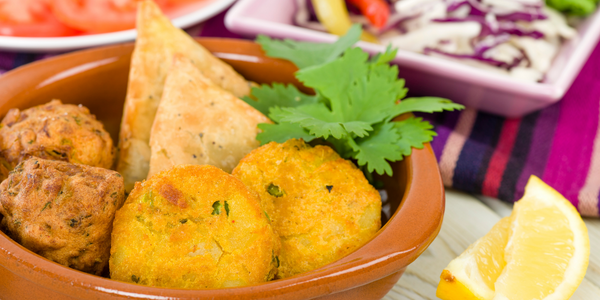
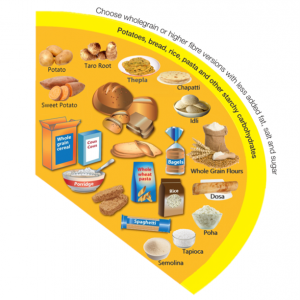
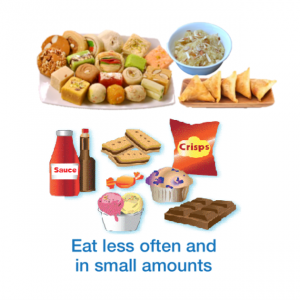
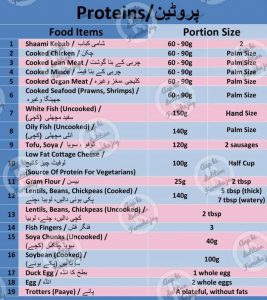
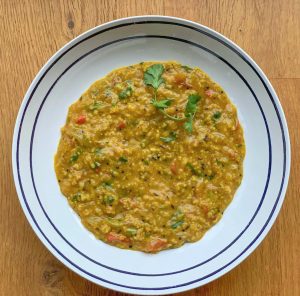





it’s a good work .
That looks to be really useful. I am not familiar with some of the foods mentioned.
Very useful information. Are there any other south Asian healthy eating recipes can you share?
Any more links to South Asian recipes would be greatly appreciated
Hi Subhas. Many thanks. Fareeha suggests the following websites for recipes:
https://nhsforthvalley.com/wp-content/uploads/2022/01/z138_healthymealshealthyheart1_booklet.pdf
https://www.srchc.ca/wp-content/uploads/2017/06/South-Asian-Cookbook-Diabetes-Healthy-Eating-Insight.pdf
Fareeha also highlights that South Asian recipes can be healthy but to limit deep frying and large amounts of oil.